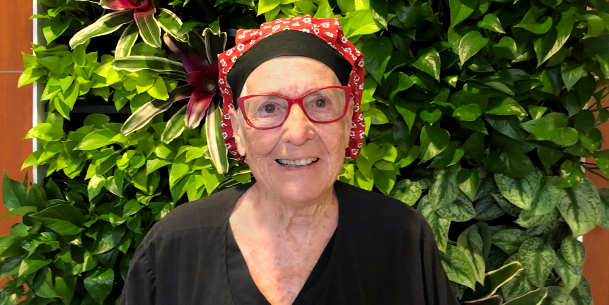
A lot of things about nursing have changed during her six decades as a nurse, Gloria McBride says, but its core has stayed consistent – caring for every patient as an individual, one by one.
“Serving patients is still the same,” says Gloria, an operating room nurse at the Mayfield Spine Surgery Center. “That person is not a number. They still are a person in my presence, a person who needs care in a surgical setting. My job is to take care of them.”
She started her career in 1958, when she graduated from the Deaconess College of Nursing. She has worked in most of Cincinnati’s operating rooms, including some side-by-side with her late husband, a former Mayfield neurosurgeon. She started in 2012 at the Mayfield Spine Surgery Center, where she helps get patients ready for outpatient surgery and promote the best outcomes.
“She has this massive memory bank of experience. She has seen just about everything,” says Mayfield neurosurgeon Dr. William Tobler, who first worked with Gloria in the early 1980s and continues today.
“Her focus and energy are amazing,” Dr. Tobler says. “She works as hard or harder than anybody. What stands out about Gloria is her focus on the real goals of nursing – excellent care with the patient at the center.”
Just a few weeks ago, Dr. Tobler says, Gloria brought in homemade cookies for the entire staff to enjoy. And her colleagues say her experience allows her to speak out on patients’ behalf.
“Gloria is always an advocate for the patient,” says Julia Toy, clinical director at the surgery center. “She is someone I would want to take care of me.”
Today, Gloria lives in Bridgetown and works several days a week at the Mayfield Spine Surgery Center, just off Interstate 71 in Norwood.
Gloria says technology advancements in the operating room have dramatically altered the precision and efficiency of surgeries. The first microscopes were adapted for neurosurgery in the late 1950s. Before that, physicians relied exclusively on surgical “loupes” or small magnifiers mounted on the lens of glasses. Loupes are still used today as well.
Computerization and image guidance technology have been another game-changer, she says. High-resolution images have enhanced surgeries including spinal fusions, allowing precise placement of screws, for example. The precision continues to improve, with a direct impact on the life-changing results for patients.
“State-of-the-art technology and training have drastically changed and improved the reach of neurosurgery,” Gloria says. “I have grown with it.”
Another change – patients are more informed.
“Frequently a patient will tell me that they watched their surgery online,” she says. “You actually get to speak more with patients about the technical aspects of their surgery.”
Gloria says interacting with patients is what keeps her always progressing.
“It keeps me mentally alert,” she says. “I’m always learning.”
The Mayfield Spine Surgery Center is operated by United Surgical Partners International in a collaboration with Mayfield Brain & Spine physicians, who have performed more than 82,000 procedures at the facility since it opened in 2007.